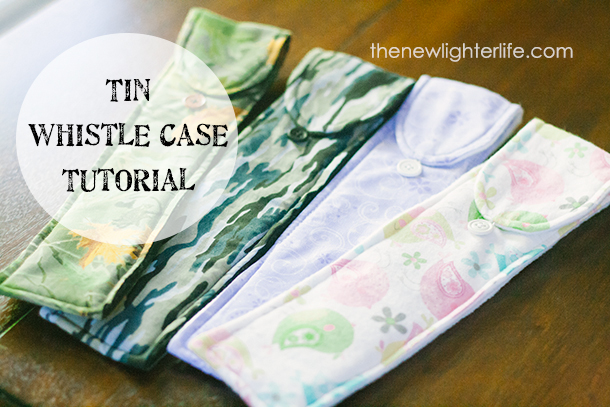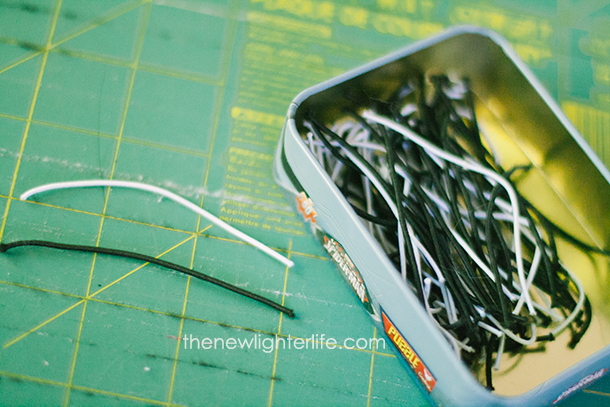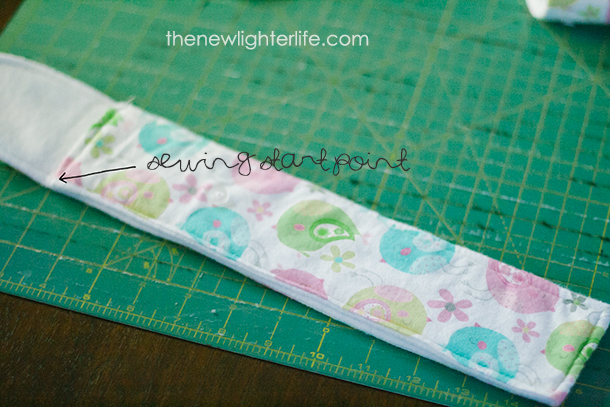We are venturing into the land of Tin Whistle with Classical Conversations. Today I’m sharing my tin whistle case tutorial. This pattern is super easy and fast if you have more than one to make. The cases are just the right length for your tin whistle and have fleece for added cushioning.

Supplies:
- 1/8 yard fleece
- 1/8 yard cotton fabric
- thread
- button
- elastic
cord**See my note below**
**NOTE: I originally used the elastic cord but due to the fact that the cord is so narrow, it’s difficult for the stitches to “grab” the cord. I repaired a couple of cases with thicker, (but still narrow elastic). The pictures below show the elastic cord but I highly recommend you use 1/8″ wide elastic instead.
Directions:
- Cut both the fleece and cotton fabric to a 3 1/2 inch strip the long way of the fabric.
- Trim both fleece and cotton to be 27 inches long.
- Cut 3 inches of elastic
cord, set aside.
- Layer fleece on bottom and place cotton on top of fleece strip with the right side of the cotton facing the fleece.
- Mark one end of fabric layers with a semi-circle. (I used a mason jar to outline.)

- Take your cut elastic and fold it in half. Place the looped end inside the fabric layers. Secure it in place with 2 pins, one on each side of the elastic. Sidenote: I NEVER pin, but in this case it’s important to pin in order to stop the elastic from shifting during the next step.
- Leave the unmarked 3 1/2″ end open and sew a 1/4″ seam allowance. When you reach the semi-circle marked end, curve around using your marking as a guide. Reinforce the elastic by sewing back and forth directly over the elastic like a crazy person. Seriously. *smile* This is very important for making sure it is secure.

- Trim the curved end of fabric, leaving the excess cording, (just in case any repairs need to be made to cording).

- Turn your fabric right side out and iron (I also NEVER iron unless it’s absolutely necessary…it is in this case).
- Tuck fabric ends under and sew a 1/4 inch seam to secure the open end closed.

- Lay your case down and fold it so that the pocket opening to the end measures 12 inches.

- Turn top flap over and mark where your button will be fastened. You want to mark for your button hole just a little past where your elastic loop falls.

- Sew on your button by hand.
- Line your case up so that it is 12 inches long (for the pocket) again.
- Starting at the pocket opening, sew at 1/4″ (make sure to backstitch at both left and right openings) all the way around the case including the opening flap. Your stitch should stop where you started to sew.

That’s it! You’ve finished.
I tried to be very detailed in how I made these. I made about 30 of these for a fundraiser in our community and this was fastest and easiest way I came up with.
You could add a tag to write a name…customizations are endless on these!
Very cute! Simple ,fast,and useful … I like it! Thanks!
Hi there, I just tried making this bag – awesome tutorial! But one thing I am wondering. When I cut my fabric 24 inches, I didn’t have enough to make the flap. I see on your picture that there seems to be an extra 3 inches for the flap – so should I be cutting my fabric 27 or 28 inches long initially? Thanks! 🙂
Oops! That was a typo! I updated the tutorial to read 27 inches as that was actually how long it should have been cut. So sorry!
I also updated the tutorial for a different type of elastic, I now recommend 1/8″ wide elastic as it’s more secure and less likely to slip out of the cover. Hope this helps!
We made these today and they turned out great! We substituted cut hair elastics for the regular elastic and it worked just fine. It gave it a cute pop of color too. Thanks for this tutorial. We can’t wait to show all of our CC friends our cute cases.
Yay!! So glad this worked for you Michellle!
I am going to try to make myself one of these but add a strap.
I have made several of these. The 27 inch measurement is fine for Clark whistles. Other whistles are a bit longer, and 28 inches seems to fit better. Also, I found that if I made the first seams narrow (scant 1/4″) and the final stitching a bit wider, it fit under my walking foot better and the final edges looked prettier. It doesn’t much matter if you are using similar colors for the cotton and the fleece, but I wanted a dark outer and a light fleece, so the layering became a bit more fussy.
Thank you so much for the information Vick!